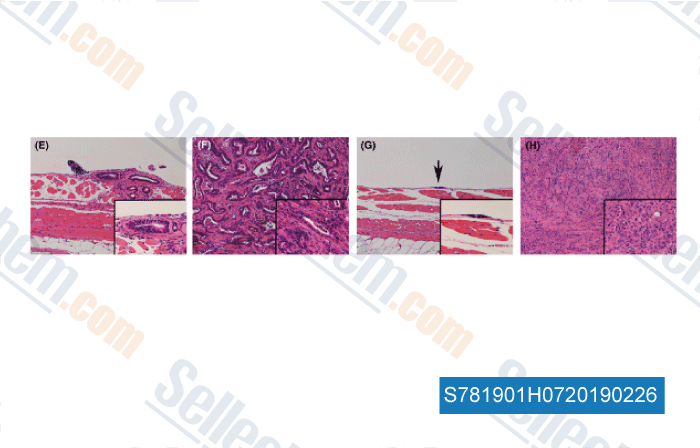|
Toll Free: (877) 796-6397 -- USA and Canada only -- |
Fax: +1-832-582-8590 Orders: +1-832-582-8158 |
Tech Support: +1-832-582-8158 Ext:3 Please provide your Order Number in the email. |
Technical Data
| Formula | C26H22Cl2N4O3 |
|||
| Molecular Weight | 509.38 | CAS No. | 1538604-68-0 | |
| Solubility (25°C)* | In vitro | DMSO | 100 mg/mL (196.31 mM) | |
| Water | Insoluble | |||
| Ethanol | Insoluble | |||
|
* <1 mg/ml means slightly soluble or insoluble. * Please note that Selleck tests the solubility of all compounds in-house, and the actual solubility may differ slightly from published values. This is normal and is due to slight batch-to-batch variations. * Room temperature shipping (Stability testing shows this product can be shipped without any cooling measures.) |
||||
Preparing Stock Solutions
Biological Activity
| Description | BLU9931 is a potent, selective, and irreversible FGFR4 inhibitor with IC50 of 3 nM, about 297-, 184-, and 50-fold selectivity over FGFR1/2/3, respectively. | ||||
|---|---|---|---|---|---|
| Targets |
|
||||
| In vitro | In MDA-MB-453 cells, BLU9931 potently inhibits phosphorylation of FGFR4 signaling pathway. BLU9931 inhibits proliferation of HCC cell lines that express an intact FGFR4 signaling complex, such as Hep 3B, HUH-7, and JHH-7 cell lines, with EC50 of <1 μM. BLU9931 also inhibits proliferation in PDX-derived cell lines with an intact FGFR4 signaling pathway. [1] | ||||
| In vivo | In mice bearing the FGF19-amplified Hep 3B liver tumors, BLU9931 (300 mg/kg, p.o.) leads to tumor regression and prevents this weight loss induced by tumors. In mice bearing the FGF19-overexpressing PDX-derived LIXC012 xenografts, treatment with BLU9931 (300 mg/kg, p.o.) also leads to tumor regression. [1] |
Protocol (from reference)
| Kinase Assay:[1] |
|
|---|---|
| Cell Assay:[1] |
|
| Animal Study:[1] |
|
Customer Product Validation

-
Data from [Data independently produced by , , Cancer Science, 2018, doi:10.1111/cas.13569]
Selleck's BLU9931 has been cited by 23 publications
| Fibroblast growth factor 23 and fibroblast growth factor receptor 4 promote cardiac metabolic remodeling in chronic kidney disease [ Kidney Int, 2025, S0085-2538(25)00087-0] | PubMed: 39923962 |
| FGF receptors mediate cellular senescence in the cystic fibrosis airway epithelium [ JCI Insight, 2024, 9(15)e174888] | PubMed: 38916962 |
| FGFR4 Is Required for Concentric Growth of Cardiac Myocytes during Physiologic Cardiac Hypertrophy [ J Cardiovasc Dev Dis, 2024, 11(10)320] | PubMed: 39452290 |
| FGFR4 and EZH2 inhibitors synergistically induce hepatocellular carcinoma apoptosis via repressing YAP signaling [ J Exp Clin Cancer Res, 2023, 42(1):96] | PubMed: 37085881 |
| FGFR4 and EZH2 inhibitors synergistically induce hepatocellular carcinoma apoptosis via repressing YAP signaling [ J Exp Clin Cancer Res, 2023, 42(1):96] | PubMed: 37085881 |
| Crosstalk with lung fibroblasts shapes the growth and therapeutic response of mesothelioma cells [ Cell Death Dis, 2023, 10.1038/s41419-023-06240-x] | PubMed: 37938546 |
| Fibroblast Growth Factor 23 Signaling Does Not Increase Inflammation from Pseudomonas aeruginosa Infection in the Cystic Fibrosis Bronchial Epithelium [ Medicina (Kaunas), 2023, 10.3390/medicina59091635] | PubMed: 37763754 |
| Fibroblast Growth Factor (FGF) 23 and FGF Receptor 4 promote cardiac metabolic remodeling in chronic kidney disease [ Res Sq, 2023, rs.3.rs-3705543] | PubMed: 38196615 |
| Fibroblast Growth Factor 23 Signaling Does Not Increase Inflammation from Pseudomonas aeruginosa Infection in the Cystic Fibrosis Bronchial Epithelium [ Medicina (Kaunas), 2023, 59(9)1635] | PubMed: 37763754 |
| 18F-FDG PET as an imaging biomarker for the response to FGFR-targeted therapy of cancer cells via FGFR-initiated mTOR/HK2 axis [ Theranostics, 2022, 12(14):6395-6408] | PubMed: 36168616 |
RETURN POLICY
Selleck Chemical’s Unconditional Return Policy ensures a smooth online shopping experience for our customers. If you are in any way unsatisfied with your purchase, you may return any item(s) within 7 days of receiving it. In the event of product quality issues, either protocol related or product related problems, you may return any item(s) within 365 days from the original purchase date. Please follow the instructions below when returning products.
SHIPPING AND STORAGE
Selleck products are transported at room temperature. If you receive the product at room temperature, please rest assured, the Selleck Quality Inspection Department has conducted experiments to verify that the normal temperature placement of one month will not affect the biological activity of powder products. After collecting, please store the product according to the requirements described in the datasheet. Most Selleck products are stable under the recommended conditions.
NOT FOR HUMAN, VETERINARY DIAGNOSTIC OR THERAPEUTIC USE.
